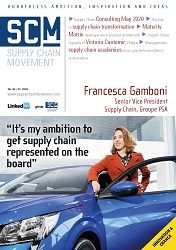Innovate or die

Over the past decades, innovation has become a buzzword that seems to appear at least once in any article that’s more than a hundred words long. The term ‘innovate or die’ is often used to emphasize just how important it is to come up with new ideas. Due to the ever-faster pace of technological advancement, digitalization and global connectivity, we face an ever-growing choice of new products and services. But what’s new and exciting today will be old news by tomorrow.
By Arthur van Gerven
In today’s turbulent society, almost everyone has some degree of involvement in the development and improvement of products, services and processes. Many organizations take pride in their new solutions, but have actually lost sight of the real aim of innovation and are really just innovating for the sake of it. So where does it all go wrong? There is often a lack of focus on the human impact. In reality, people – whether customers, employees, colleagues, suppliers or any other stakeholders – play the key role. No matter how superior or unique the technology is, it’s pointless if people can’t accept and embrace it. I’ve had personal experience of this during the implementation of a new transport management system (TMS) at a large logistics service provider. A small group of specialists drew up the design requirements. However, nobody had really listened to the actual users, which meant that a long list of seemingly minor issues that suddenly needed to be resolved was left out of the selection and implementation. As a result, following a year of immense dissatisfaction and frustration among the users, the project was scrapped, incurring a huge capital loss.
The value of an innovation is ultimately determined by people. People know where the needs lie, where the bottlenecks are and whether new solutions are necessary. Listen to your people.
Collective intelligence
Seeing as people play the key role in organizations and are so important for the success of innovations, it seems only logical that we should make maximum use of their knowledge and experience. However, that happens less than you might think in practice. Innovations often stem from a small group within the organization, sometimes prompted by the management based on supposed needs. Companies rarely make effective use of the huge potential knowledge, inspiration, experience and engagement that is available to them, which often results in numerous missed opportunities.
Nowadays, a rising number of large organizations – including many successful names such as Google, Netflix, Lufthansa, Nestlé and Swiss Post – are engaging in dialogue about this with their employees, customers and suppliers. Supply chain organizations are slowly but surely becoming aware of this need too, and we’re seeing them gradually shifting their attention onto the use of collective intelligence.
New recruits full of ideas for innovations
A structural process including tools that activate an organization’s collective intelligence is not only useful in generating new ideas or identifying the organization’s or the market’s real need. Such a process also creates a common ground for innovation and fosters engagement. You’ve no doubt seen plenty of examples of your own in which young, enthusiastic, highly educated new recruits – lured by appealing promises and plans – are full of ideas for innovations and improvements. But when they discuss them with their manager or older colleagues they are often waved away or fobbed off with a feeble excuse. The result: their enthusiasm fades, innovation dries up, engagement takes a nosedive and, in the worst-case scenario, the young colleague might even quit, leaving you to start the recruitment process all over again. Does it sound familiar?
Successful organizations make a point of listening to their people and asking for their opinions and ideas. They encourage them to contribute and they value their input. They give their people the chance to experiment, to fail and to learn from their mistakes. They verify their policies and involve their people in the planning process in an interactive and transparent way. This results in a huge boost for engagement and morale as well as a steady stream of new ideas. Perhaps surprisingly, the best ideas often come from where you least expect: the temporary warehouse operative who has a brilliant suggestion for process optimization, or the secretary who thinks up a new product by accident. One good example is Starbucks, which introduced an idea management system to give not only its employees but also its customers the opportunity to submit innovative ideas. It received 70,000 suggestions in the first year, and many of them have since been implemented!
Change management
I regularly speak to executive boards that implement policies or new processes because they think they address a need, only to discover that the real need lies elsewhere. This leads to disappointment all round; ‘If only we’d asked the people first.’ they think. Luckily, change management is receiving ever-more attention. Managers and executives are realizing that they can’t simply push through innovations without aligning them with the needs and involving the users in the implementation process. Watch what happens when you listen to your people.
Arthur van Gerven is Co-founder and Chief Operations Officer at Sparq360, a consultancy firm specialized in innovation, continuous improvement, change management and supply chain.










